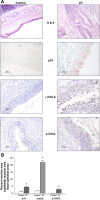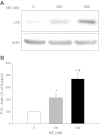Increased expression of senescence markers in cystic fibrosis airways
- PMID: 23316069
- PMCID: PMC3602742
- DOI: 10.1152/ajplung.00091.2012
Increased expression of senescence markers in cystic fibrosis airways
Abstract
Cystic Fibrosis (CF) is a chronic lung disease characterized by chronic neutrophilic airway inflammation and increased levels of neutrophil elastase (NE) in the airways. We have previously reported that NE treatment triggers cell cycle arrest. Cell cycle arrest can lead to senescence, a complete loss of replicative capacity. Importantly, senescent cells can be proinflammatory and would perpetuate CF chronic inflammation. By immunohistochemistry, we evaluated whether airway sections from CF and control subjects expressed markers of senescence, including p16(INK4a) (p16), a cyclin-dependent kinase inhibitor, phospho-Histone H2A.X (γH2A.X), and phospho-checkpoint 2 kinase (phospho-Chk2), which are also DNA damage response markers. Compared with airway epithelium from control subjects, CF airway epithelium had increased levels of expression of all three senescence markers. We hypothesized that the high load of NE in the CF airway triggers epithelial senescence by upregulating expression of p16, which inhibits cyclin-dependent kinase 4 (CDK4). Normal human bronchial epithelial (NHBE) cells, cultured in air-liquid interface were treated with NE (0, 200, and 500 nM) to induce visible injury. Total cell lysates were collected and evaluated by Western analysis for p16 protein expression and CDK4 kinase activity. NE significantly increased p16 expression and decreased CDK4 kinase activity in NHBE cells. These results support the concept that NE triggers expression of senescence markers in CF airway epithelial cells.
Figures






Similar articles
-
Involvement of the cyclin-dependent kinase inhibitor p16 (INK4a) in replicative senescence of normal human fibroblasts.Proc Natl Acad Sci U S A. 1996 Nov 26;93(24):13742-7. doi: 10.1073/pnas.93.24.13742. Proc Natl Acad Sci U S A. 1996. PMID: 8943005 Free PMC article.
-
FGF receptors mediate cellular senescence in the cystic fibrosis airway epithelium.JCI Insight. 2024 Jun 25;9(15):e174888. doi: 10.1172/jci.insight.174888. JCI Insight. 2024. PMID: 38916962 Free PMC article.
-
Differential roles for cyclin-dependent kinase inhibitors p21 and p16 in the mechanisms of senescence and differentiation in human fibroblasts.Mol Cell Biol. 1999 Mar;19(3):2109-17. doi: 10.1128/MCB.19.3.2109. Mol Cell Biol. 1999. PMID: 10022898 Free PMC article.
-
Role of Cystic Fibrosis Bronchial Epithelium in Neutrophil Chemotaxis.Front Immunol. 2020 Aug 4;11:1438. doi: 10.3389/fimmu.2020.01438. eCollection 2020. Front Immunol. 2020. PMID: 32849500 Free PMC article. Review.
-
Neutrophil Elastase and Chronic Lung Disease.Biomolecules. 2021 Jul 21;11(8):1065. doi: 10.3390/biom11081065. Biomolecules. 2021. PMID: 34439732 Free PMC article. Review.
Cited by
-
Glycosaminoglycans as Multifunctional Anti-Elastase and Anti-Inflammatory Drugs in Cystic Fibrosis Lung Disease.Front Pharmacol. 2020 Jul 8;11:1011. doi: 10.3389/fphar.2020.01011. eCollection 2020. Front Pharmacol. 2020. PMID: 32733248 Free PMC article. Review.
-
Leukocyte telomere length and attrition in association with disease severity in cystic fibrosis patients.Aging (Albany NY). 2024 Aug 29;16(16):11809-11823. doi: 10.18632/aging.206093. Epub 2024 Aug 29. Aging (Albany NY). 2024. PMID: 39213174 Free PMC article.
-
Targeting Senescent Cells in Fibrosis: Pathology, Paradox, and Practical Considerations.Curr Rheumatol Rep. 2018 Jan 26;20(1):3. doi: 10.1007/s11926-018-0712-x. Curr Rheumatol Rep. 2018. PMID: 29374361 Review.
-
ROS, Cell Senescence, and Novel Molecular Mechanisms in Aging and Age-Related Diseases.Oxid Med Cell Longev. 2016;2016:3565127. doi: 10.1155/2016/3565127. Epub 2016 May 10. Oxid Med Cell Longev. 2016. PMID: 27247702 Free PMC article. Review.
-
Discovery of dysregulated circular RNAs in whole blood transcriptomes from cystic fibrosis patients - implication of a role for cellular senescence in cystic fibrosis.J Cyst Fibros. 2023 Jul;22(4):683-693. doi: 10.1016/j.jcf.2023.04.021. Epub 2023 May 2. J Cyst Fibros. 2023. PMID: 37142522 Free PMC article.
References
-
- Aoshiba K, Yasuda K, Yahui S, Tamaoki J, Nagai A. Serine proteases increase oxidative stress in lung cells. Am J Physiol Lung Cell Mol Physiol 281: L556–L564, 2001 - PubMed
-
- Barash H, ERG , Edrei Y, Ella E, Israel A, Cohen I, Corchia N, Ben-Moshe T, Pappo O, Pikarsky E, Goldenberg D, Shiloh Y, Galun E, Abramovitch R. Accelerated carcinogenesis following liver regeneration is associated with chronic inflammation-induced double-strand DNA breaks. Proc Natl Acad Sci USA 107: 2207–2212, 2010 - PMC - PubMed
-
- Birrer P, McElvaney NG, Rudeberg A, Sommer CW, Liechti-Gallati S, Kraemer R, Hubbard R, Crystal RG. Protease-antiprotease imbalance in the lungs of children with cystic fibrosis. Am J Respir Crit Care Med 150: 207–213, 1994 - PubMed
-
- Brennan S, Sly PD, Gangell CL, Sturges N, Winfield K, Wikstrom M, Gard S, Upham JW. Alveolar macrophages and CC chemokines are increased in children with cystic fibrosis. Eur Respir J 34: 655–661, 2009 - PubMed
Publication types
MeSH terms
Substances
Grants and funding
LinkOut - more resources
Full Text Sources
Other Literature Sources
Medical

